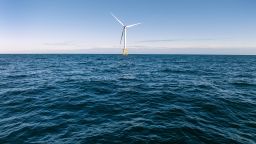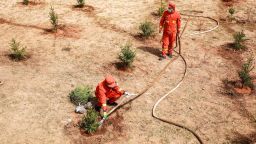Editor’s Note: Jane Alexander is former chair of the National Endowment for the Arts. She has served on the boards of Audubon, Wildlife Conservation Society and the American Bird Conservancy. Alexander is author of “Wild Things, Wild Places: Adventurous Tales of Wildlife and Conservation on Planet Earth.” She is also a Tony and Emmy Award-winning and Academy Award-nominated actress. The views expressed in this commentary are her own. Read more opinion articles on CNN.
From my home in southwest Nova Scotia, I look out on the warming and rising Atlantic Ocean with alarm. This summer, the kelp forest, nursery to so many aquatic species, was bleaching out in its struggle to cope with temperature. This continued years of decline in this precious aquatic ecosystem.
The beach by my home was a graveyard for eiders, guillemots, gulls, curlews and other birds, many of which succumbed to their own pandemic — avian flu — which has been devastating seabirds throughout Canada’s Atlantic provinces.

Meanwhile, my local spruce trees and other conifers are giving way to deciduous trees, ending much of the seed cone production that rodents, birds and insects depend on.
It is with this urgency and in my capacity as a board member of the conservation nonprofit National Audubon Society that I am attending the United Nations Convention on Biodiversity (COP15) that started this week in Montreal.
As this vitally important convention gets underway, here is what we know: Because of human activity, life on Earth is undergoing an extinction crisis approximately 1,000 times faster than natural rates, according to a landmark study published in Conservation Biology. The Intergovernmental Science-Policy Platform on Biodiversity and Ecosystem Services reports that 1 million species face extinction at our hands. A 2019 Science paper led by the Cornell Lab of Ornithology reports that North America has lost nearly 3 billion birds — 29% of the continent’s total — since 1970, and BirdLife International shows nearly half of all birds declining worldwide.
We are tearing holes in the fabric of life on Earth that supports our own human lives. We rely on Earth’s diverse and varied forms of life for food, medicine, clean air and water, our mental health, inspiration and materials for great feats of art and engineering, pure joy and recreation — and so much more.
Yet there is hope. In my lifetime, for example, bald eagles, peregrine falcons and ospreys have rebounded sharply from mid-20th century population crashes that resulted from widespread use of the insecticide DDT, which caused birds’ eggshells to thin and break. Banning the pesticide led to their recovery.
All of this is why countries must reach a robust, meaningful agreement to protect global biodiversity in Canada. And there are three steps we can take to achieve that goal.
First, we must recognize, support and fund indigenous leadership. The World Bank has estimated that indigenous territories hold 80% of the world’s remaining biodiversity. In Canada, the Indigenous Guardians and Indigenous Protected Areas programs are having success in defending vast swaths of boreal forest.
But indigenous environmental activists are often at risk of threats, harm and even death at the hands of criminals profiting from illegal logging, mining, land seizures and other activities. For example, a 2022 Mongabay investigation found that dozens of indigenous environmentalists were killed in the Amazon basin from 2016 to 2021 and that most of the investigations into their deaths face “delays and irregularities.”
Too often, governments and NGOs still fail to honor and invest in indigenous peoples’ rights and expertise across the board. We can change this, and we must.
Second, nature can help us solve the climate crisis, so let’s invest in climate solutions that are based in biodiversity and healthy natural ecosystems. For example, coniferous boreal forests cover 11% of Earth’s surface but store a third of terrestrial carbon and serve as vast living sponges to soak up and safely store carbon from the atmosphere.
If we intend to limit global warming and avert the worst impacts of climate change, we must protect and restore our northern forests. The same thing is true for wetlands, grasslands, temperate and tropical forests, marine ecosystems and even landscape architecture in urban areas. The recently announced White House nature-based solutions roadmap is an encouraging start.
Third, world governments must commit to extraordinary action in the face of extraordinary circumstances. Apathetic half-measures simply will not do — too much is at stake. We need robust, meaningful commitments coming out of Montreal.
Among other things, that means committing funding that can get the job done. An analysis by the Paulson Institute estimated the biodiversity financing gap at an average $711 billion per year worldwide for 10 years. And it’s not just putting funds to work proactively — we also need governments to phase out subsidies that prop up nature destruction and greenhouse gas emissions.
Another example of ambitious thinking and action is the 30 by 30 initiative, which challenges world governments to protect 30% of lands and oceans by 2030. The United States and Canada are among more than 100 countries that support this global goal.
Get our free weekly newsletter
At my Nova Scotia home, I’ve found a partner in restoration and rejuvenation: a beaver, who took up residence in my pond. Thanks to the beaver dam, small fish, frogs, turtles and insects are thriving, feeding all manner of creatures. Beavers, Canada’s national emblem, were once threatened with extinction by overhunting for their pelts. Life finds a way if we give it a chance.
On a global stage now, let’s give life a chance — we’ll be rewarded with human wellbeing and great joy.






